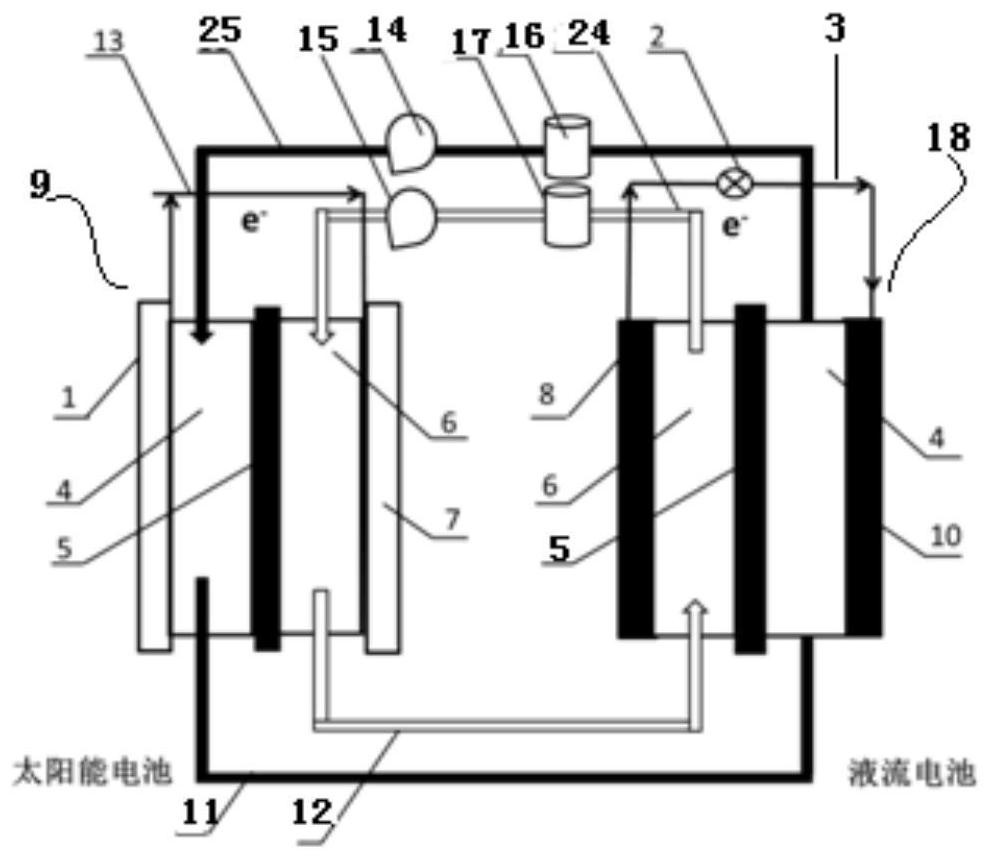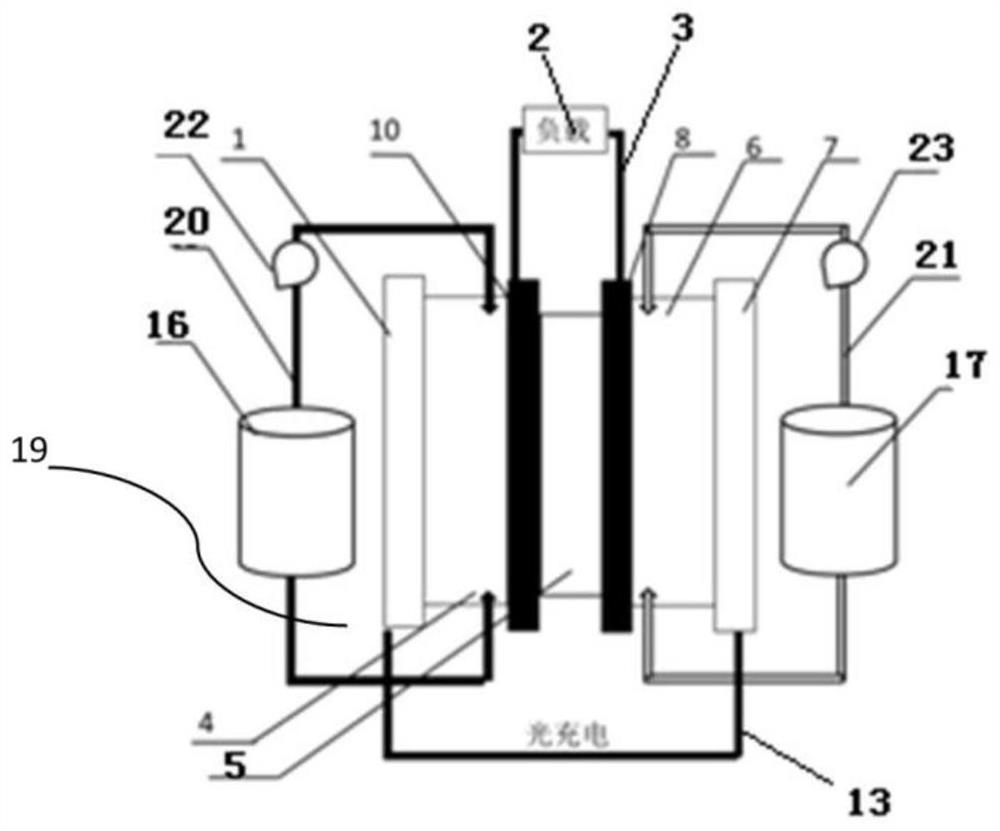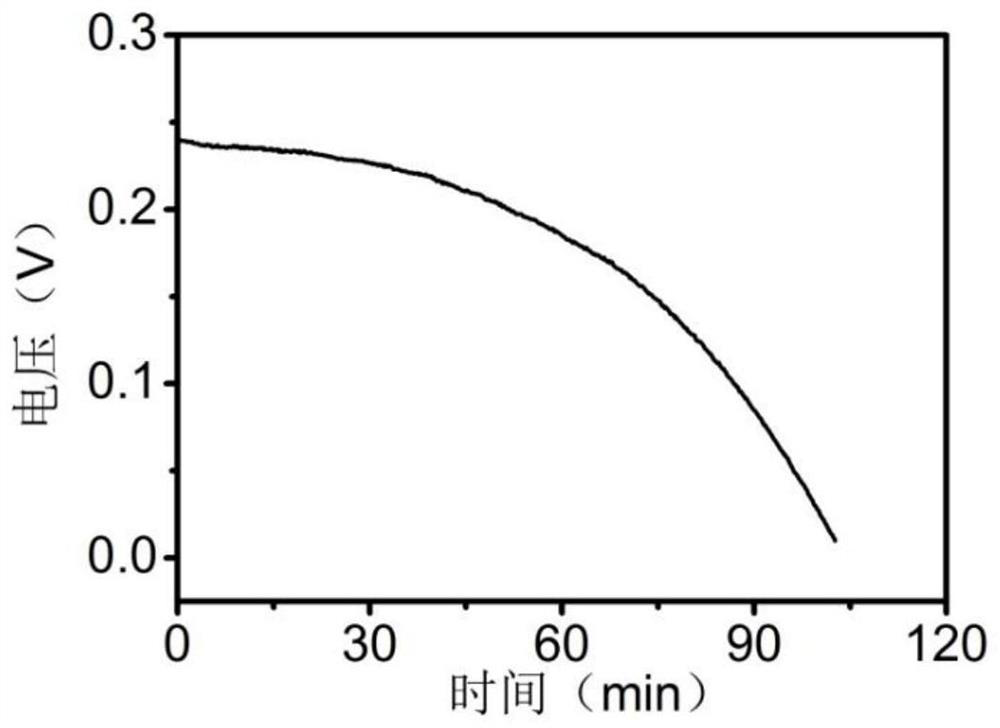Photoelectrochemical energy storage battery
An energy storage battery and photoelectrochemical technology, applied in solar cells, electrochemical generators, circuits, etc., can solve the problems of inability to realize direct conversion and storage of solar energy, high price, and increased battery cost
- Summary
- Abstract
- Description
- Claims
- Application Information
AI Technical Summary
Problems solved by technology
Method used
Image
Examples
Embodiment 1
[0041] The photoanode is titanium dioxide.
[0042] The ion exchange membrane is a cation-permeable membrane (Nafion membrane), which only allows cations to pass through.
[0043] The counter electrode is metal platinum sheet.
[0044] The positive electrode is carbon paper;
[0045] The negative electrode is carbon paper.
[0046] The positive electrode electrolyte is a mixture of iodine active material, the first auxiliary electrolyte and water, the first auxiliary electrolyte is potassium chloride, the concentration of the first auxiliary electrolyte in the positive electrode electrolyte is 1mol / L, the iodine active material is potassium iodide, and the positive electrode electrolyte The concentration of iodide ion in the iodine active substance is 0.5mol / L.
[0047] The negative electrode electrolyte is a mixture of iron ion coordination compound active material, the second auxiliary electrolyte and water, the second auxiliary electrolyte is potassium chloride, the conc...
Embodiment 2
[0050] The photoanode is dye-sensitized titanium dioxide.
[0051] The ion exchange membrane is a cation-permeable membrane (Nafion membrane), which only allows cations to pass through.
[0052] The counter electrode is metal platinum sheet.
[0053] The positive electrode is carbon paper;
[0054] The negative electrode is carbon paper.
[0055]The positive electrode electrolyte is a mixture of iodine active material, the first auxiliary electrolyte and water, the first auxiliary electrolyte is potassium chloride, the concentration of the first auxiliary electrolyte in the positive electrode electrolyte is 2mol / L, the iodine active material is potassium iodide, and the positive electrode electrolyte The concentration of iodide ion in the iodine active substance is 0.3mol / L.
[0056] The negative electrode electrolyte is a mixture of iron ion coordination compound active material, the second auxiliary electrolyte and water, the second auxiliary electrolyte is potassium chlo...
Embodiment 3
[0059] The photoanode is ferric oxide.
[0060] The ion exchange membrane is a cation-permeable membrane (Nafion membrane), which only allows cations to pass through.
[0061] The counter electrode is metal platinum sheet.
[0062] The positive electrode is carbon paper;
[0063] The negative electrode is carbon paper.
[0064] The positive electrode electrolyte is a mixture of iodine active substance, the first auxiliary electrolyte and water, the first auxiliary electrolyte is potassium chloride, the concentration of the first auxiliary electrolyte in the positive electrode electrolyte is 3mol / L, the iodine active substance is potassium iodide, and the positive electrode electrolyte The concentration of iodide ion in the iodine active substance is 0.5mol / L.
[0065] The negative electrode electrolyte is a mixture of iron ion coordination compound active material, the second auxiliary electrolyte and water, the second auxiliary electrolyte is potassium chloride, the concen...
PUM
 Login to View More
Login to View More Abstract
Description
Claims
Application Information
 Login to View More
Login to View More - R&D
- Intellectual Property
- Life Sciences
- Materials
- Tech Scout
- Unparalleled Data Quality
- Higher Quality Content
- 60% Fewer Hallucinations
Browse by: Latest US Patents, China's latest patents, Technical Efficacy Thesaurus, Application Domain, Technology Topic, Popular Technical Reports.
© 2025 PatSnap. All rights reserved.Legal|Privacy policy|Modern Slavery Act Transparency Statement|Sitemap|About US| Contact US: help@patsnap.com



